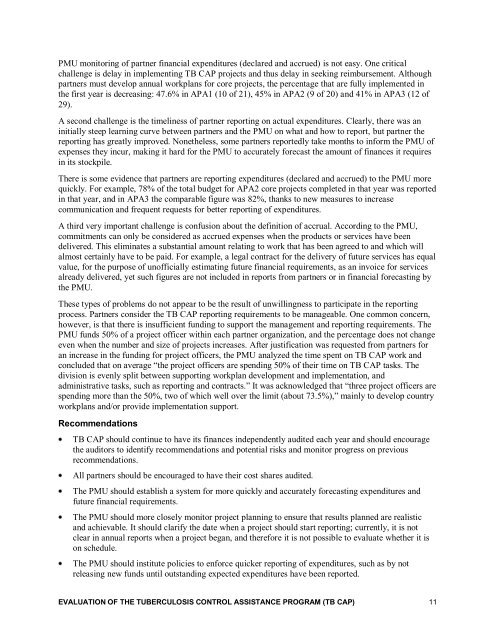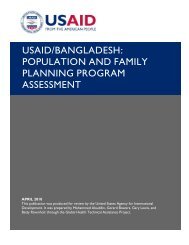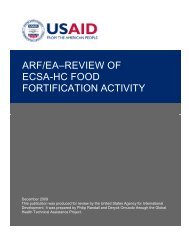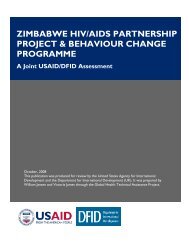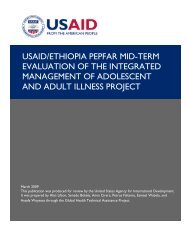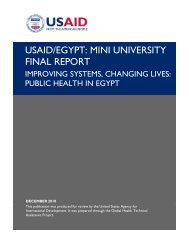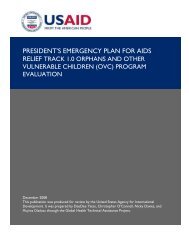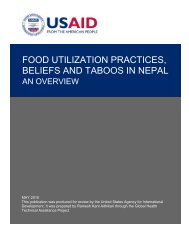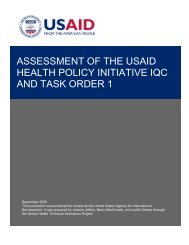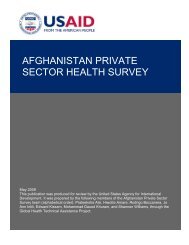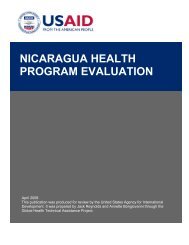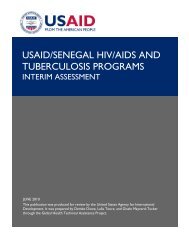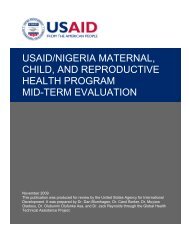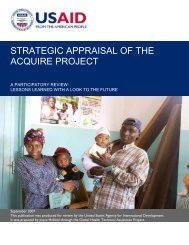Evaluation of the Tuberculosis Control Assistance Program (TB CAP)
Evaluation of the Tuberculosis Control Assistance Program (TB CAP)
Evaluation of the Tuberculosis Control Assistance Program (TB CAP)
Create successful ePaper yourself
Turn your PDF publications into a flip-book with our unique Google optimized e-Paper software.
PMU monitoring <strong>of</strong> partner financial expenditures (declared and accrued) is not easy. One criticalchallenge is delay in implementing <strong>TB</strong> <strong>CAP</strong> projects and thus delay in seeking reimbursement. Althoughpartners must develop annual workplans for core projects, <strong>the</strong> percentage that are fully implemented in<strong>the</strong> first year is decreasing: 47.6% in APA1 (10 <strong>of</strong> 21), 45% in APA2 (9 <strong>of</strong> 20) and 41% in APA3 (12 <strong>of</strong>29).A second challenge is <strong>the</strong> timeliness <strong>of</strong> partner reporting on actual expenditures. Clearly, <strong>the</strong>re was aninitially steep learning curve between partners and <strong>the</strong> PMU on what and how to report, but partner <strong>the</strong>reporting has greatly improved. None<strong>the</strong>less, some partners reportedly take months to inform <strong>the</strong> PMU <strong>of</strong>expenses <strong>the</strong>y incur, making it hard for <strong>the</strong> PMU to accurately forecast <strong>the</strong> amount <strong>of</strong> finances it requiresin its stockpile.There is some evidence that partners are reporting expenditures (declared and accrued) to <strong>the</strong> PMU morequickly. For example, 78% <strong>of</strong> <strong>the</strong> total budget for APA2 core projects completed in that year was reportedin that year, and in APA3 <strong>the</strong> comparable figure was 82%, thanks to new measures to increasecommunication and frequent requests for better reporting <strong>of</strong> expenditures.A third very important challenge is confusion about <strong>the</strong> definition <strong>of</strong> accrual. According to <strong>the</strong> PMU,commitments can only be considered as accrued expenses when <strong>the</strong> products or services have beendelivered. This eliminates a substantial amount relating to work that has been agreed to and which willalmost certainly have to be paid. For example, a legal contract for <strong>the</strong> delivery <strong>of</strong> future services has equalvalue, for <strong>the</strong> purpose <strong>of</strong> un<strong>of</strong>ficially estimating future financial requirements, as an invoice for servicesalready delivered, yet such figures are not included in reports from partners or in financial forecasting by<strong>the</strong> PMU.These types <strong>of</strong> problems do not appear to be <strong>the</strong> result <strong>of</strong> unwillingness to participate in <strong>the</strong> reportingprocess. Partners consider <strong>the</strong> <strong>TB</strong> <strong>CAP</strong> reporting requirements to be manageable. One common concern,however, is that <strong>the</strong>re is insufficient funding to support <strong>the</strong> management and reporting requirements. ThePMU funds 50% <strong>of</strong> a project <strong>of</strong>ficer within each partner organization, and <strong>the</strong> percentage does not changeeven when <strong>the</strong> number and size <strong>of</strong> projects increases. After justification was requested from partners foran increase in <strong>the</strong> funding for project <strong>of</strong>ficers, <strong>the</strong> PMU analyzed <strong>the</strong> time spent on <strong>TB</strong> <strong>CAP</strong> work andconcluded that on average ―<strong>the</strong> project <strong>of</strong>ficers are spending 50% <strong>of</strong> <strong>the</strong>ir time on <strong>TB</strong> <strong>CAP</strong> tasks. Thedivision is evenly split between supporting workplan development and implementation, andadministrative tasks, such as reporting and contracts.‖ It was acknowledged that ―three project <strong>of</strong>ficers arespending more than <strong>the</strong> 50%, two <strong>of</strong> which well over <strong>the</strong> limit (about 73.5%),‖ mainly to develop countryworkplans and/or provide implementation support.Recommendations<strong>TB</strong> <strong>CAP</strong> should continue to have its finances independently audited each year and should encourage<strong>the</strong> auditors to identify recommendations and potential risks and monitor progress on previousrecommendations.All partners should be encouraged to have <strong>the</strong>ir cost shares audited.The PMU should establish a system for more quickly and accurately forecasting expenditures andfuture financial requirements.The PMU should more closely monitor project planning to ensure that results planned are realisticand achievable. It should clarify <strong>the</strong> date when a project should start reporting; currently, it is notclear in annual reports when a project began, and <strong>the</strong>refore it is not possible to evaluate whe<strong>the</strong>r it ison schedule.The PMU should institute policies to enforce quicker reporting <strong>of</strong> expenditures, such as by notreleasing new funds until outstanding expected expenditures have been reported.EVALUATION OF THE TUBERCULOSIS CONTROL ASSISTANCE PROGRAM (<strong>TB</strong> <strong>CAP</strong>) 11


